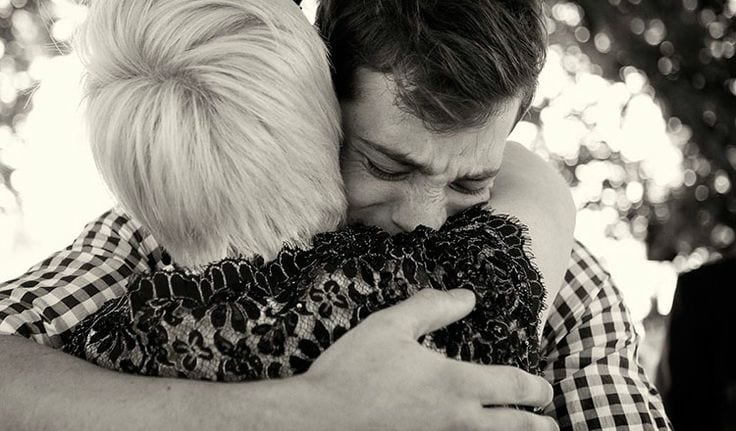Photography by John Warren
Australian journalist and death literacy advocate Lisa Herbert is about to publish the 3rd edition of her brilliant book “The Bottom Drawer Book”. Here she writes for The Carousel about the 22 things you didn’t know about death and funerals.
An American anthropologist once wrote that ‘when a person is born we rejoice, and when they’re married we jubilate, but when they die we try to pretend nothing has happened’.
Margaret Mead nailed it, and she was happy to feed the white elephant in the room that the rest of western society ignores. Sure, the subject of death and dying can often be sad and hard to swallow, but the more you learn about it, the less confronting it can become. From brightly coloured funerals, lollies in caskets, cardboard coffins, ashes in space, memorialised Facebook pages, chemical-free burials, and graves marked with nothing but GPS co-ordinates, the subject is fascinating.
When I penned The Bottom Drawer Book: The After Death Action Plan, I hoped it would get people talking and planning for the inevitable, no matter how far away it may seem. Featuring comical illustrations and humorous text, the book offers thought-provoking information and provides space for readers to leave their own ideas and plans. Then, when you go, there’ll be no squabbling over how much to spend on your casket, who’ll tell stories at your funeral or which footy jumper you’ll be buried in.
Here are just some of the things I’ve learned on my Bottom Drawer Book journey.
We don’t talk anymore
The study of death and the psychological aspects that go along with it is called thanatology. In Greek mythology Thanatos was a minor figure; the personification of death. He was rarely seen but he was often talked about. Much has changed since then; western society sees any discussion about death as morbid and taboo.
Funerals are big business
InvoCare is the largest private funeral, cemetery and crematorium operator in the Asia Pacific region. According to the company’s CEO, Andrew Smith, profits were down last year because there was a less than expected number of deaths because of ‘unseasonably warm weather’.
Your abused liver and you broken heart are still of use!
By donating your organs, or those of a family member, you many not only improve the life of someone else – you could save one.
The Australian Organ Donor Register is the only national register for people to record their decision about becoming an organ and tissue donor for transplantation after death. The Register allows authorised medical staff to check your donation decision, anytime, anywhere. They’ll then tell your family your wishes. Ultimately it’s up to your family to give the go ahead for your organ donation. Sometimes, though, families choose not to follow the wishes of their loved ones. That’s why it’s really important to have a quick chat with them well before the time comes.
To register go to www.donorregister.gov.au or call 1800 777 203.
Natural death, or is it? Preparing the body
Despite death being a very natural part of life, western society prefers to make the dead look like they were when they were alive. While embalming has a very practical use if there’s a delay in having the funeral, it’s a very invasive process. Quite common, it involves replacing the body’s fluids with some pretty serious chemicals to preserve the body. There are also some other techniques to make the deceased appear ‘not so dead’ .This preparation is usually done so those attending a viewing of the body are left with a better lasting memory of their loved one. Embalming is a choice though, not a necessity.
Cremation seems to be the way to go
The Australian Bureau of Statistics reports there were 147,098 deaths in 2012. That’s expected to steadily rise to around 160,000 by 2019. Cremation is creeping ahead of burial as the preferred funeral option for Australians. It’s thought that the cheaper cost of cremations is the main reason for its increasing popularity.
Climate change and a burning desire
Despite ongoing advancements in cremation technology, it’s been estimated that a cremation emits 160 kilograms of greenhouse gases into the atmosphere. Melbourne scientist Roger Short says the average male produces around 50 kilograms of carbon dioxide as the body is heated to 850 degrees Celsius for 90 minutes. Add to that the carbon cost of the gas used to fuel the process and the cost of emissions involved in producing and burning a wooden coffin and you’ve got a lot of pollution heading skywards.
Ashes ain’t ashes
After a cremation, calcium deposits and bits of bones remain. These are then mechanically ground into a fine powder called cremains which have a consistency more similar to sand than ashes.
Hipster recycling
Metallic compounds like artificial hips, surgical screws, metal plates, prosthesis, and coffin handles and screws are removed before the remnants of a cremation are crushed. These metals are often either buried on the crematorium grounds or melted down and recycled.
No flaming sambucas!
Forget the bottle of booze in your coffin if you are being cremated. Flammable items aren’t allowed no matter how much you want to go out with a bang.
Scattering Ashes
Scattering ashes on public land needs a bit of homework. At some locations, like local parks, scattering ashes without permission may get people into trouble. Some councils allow it, some don’t. And permission may also be needed to scatter ashes on private lands too. Last year, the ashes of at least six people were secretly scattered on the Melbourne Cricket Ground during a community open day. The MCG doesn’t allow ashes to be scattered on its turf. Generally speaking, common sense and a bit of discretion should prevail when choosing a location.
Going off with a bang
If you do want to go off with a bang, there are a couple of Aussie companies that will incorporate your ashes into a fireworks display at your wake. They will do pets as well!
Orbiting ashes
If fireworks don’t go high enough for you, perhaps a space mission is more your style? Two American companies will take a small ‘symbolic’ portion of your ashes into space alongside a commercial or research satellite. The cheapest option is a flight with sub-orbital trajectory that returns to earth after about 15 minutes. The ashes are then retrieved and returned to loved ones.
The most expensive space option is a trip into deep space. Preparations are underway for a historic NASA mission known as the Sunjammer solar sail mission. You’ll journey three million kilometres towards the sun, the farthest distance ever travelled by humankind. Fifteen people are already booked onto this 2016 mission. It’s not cheap though! It’ll cost more than $13,000 for one gram of your ashes to be sent into deep space. And don’t expect your ashes to return to earth. This mission may just take millions of years!
Coffin company
Photos are the most common items placed in coffins with loved ones. Hand knitted or crocheted blankets, teddy bears, books and lollies are common too. And yes, crooner Frank Sinatra really was buried with a roll of dimes in case he needed to make a phone call.
Coffin dress code
Despite the practical difficulties of dressing Uncle Joe in a suit, they’re still the most common choice of outfit. It’s also not uncommon for guys to be buried wearing their work uniform or their team’s footy jumper. Women are most commonly dressed in their favourite dress. Nighties are a popular choice too.
Themed funerals are no longer uncommon
While dressing ‘tastefully and conservatively’ remains the norm, funerals don’t have to be gloomy affairs. They can be a celebration of life and the dress code can reflect that. Bright colours are no longer frowned upon.
Pushing up daisies
Okay, not so much daisies. Perhaps a bottle brush tree to encourage native birds instead? Natural burials are the latest funeral buzzwords. More people are looking for funeral options that have a reduced impact on the environment. Coffins and caskets can contain all sorts of nasties such as glues and lacquers, as well being made of furniture-quality hard wood. These days, coffins and caskets can be made of many biodegradable alternatives including cardboard and willow. Embalming is also a no-no because of the chemicals used.
You can be buried in a picnic basket
Well, kind of. Wicker coffins are an environmentally friendly alternative to hardwood caskets, hand woven without glues and lacquers. If it’s good enough for Yogi Bear …
Where did they put you?
While more cemeteries are starting to offer spaces for natural burials, there are only a handful of true green burial cemeteries in Australia. As well as being chemical free, in these bushland cemeteries headstones are replaced with a native tree or shrub, a rock or even just GPS coordinates. Let’s hope your family doesn’t forget where they put you!
Engraving seashells
If you walk through any cemetery you might notice some older graves have seashells scattered on them. One of the popular theories about this originates in Greek mythology where Aphrodite, the goddess of love, was born from sea foam and then was carried to shore in a sea shell. Regarded by some as a source of life, the hard shell protects a soft, living being. This can be an analogy for someone who’s died: While a human body may be devoid of live, the soul continues to live
No longer are burials or cremation the only option
Aquamation is like cremation without the fire and is relatively new in Australia. Think of it as a spa that dissolves the body using a process called alkaline hydrolysis.
Life, and death, online
Do you really want your Christmas party photos orbiting cyberspace for eternity? Most social networking site have policies in place for dealing for your web presence when you die. For example, a family member or your will’s executor can request your Facebook or Myspace page be either deleted or memorialised. Memorialising your page will allow your friends to still write on your wall, allowing it to become a meeting place where they can chat and laugh about those Christmas party photos. It becomes like a cyber funeral.
You’re welcome to shop around
Despite being big business, most funeral directors to be open and caring. They welcome your inquiries and are happy to answer your questions. Get some friends together and book an appointment with a funeral director to discuss all options before they’re needed. Just like you’d shop around if you’re installing a new kitchen, explore your funeral options. It’s a fascinating subject and the more you learn about it, the less confronting it becomes.
About Lisa Herbert
Lisa Herbert is an ABC journalist whose interest in society’s perception of death and dying led to her penning ‘The Bottom Drawer Book: The After Death Action Plan’.
The book is for anyone that wishes to influence their own farewell. As well as providing lots of information, it provides space to document everything, from where your important documents are, through organ donation, down to what music you’d like played, the type of coffin you’d like and what you want to be wearing for your own funeral. Death touches us all, so it’s a clever idea to collate our preferences and answer the difficult questions, before they’re asked, for those we leave behind.
Brisbane cartoonist and animator Phillip Judd used his experience as a former nurse to illustrate ‘The Bottom Drawer Book: The After Death Action Plan’. He used a light illustration style to add subtle details that are often missed during the process of someone moving on. Buy the book here!









